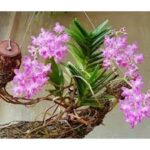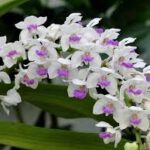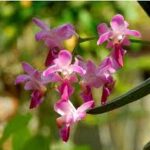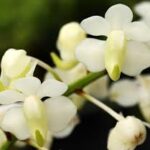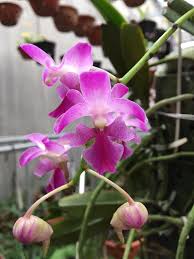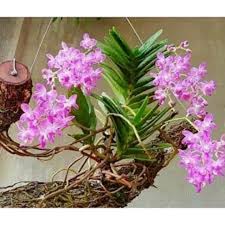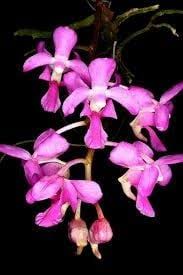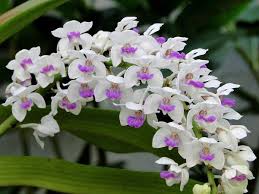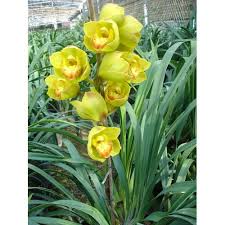
**1. Introduction to Sato Cymbidium Orchids**
Sato Cymbidium orchids, a beloved group within the orchid family, have captivated horticulturists and plant enthusiasts alike for their stunning blooms, diverse shapes, and vibrant colors. Originally cultivated in Asia, particularly in Japan, these orchids have gained immense popularity worldwide. With a rich history of cultivation, breeding, and hybridization, the Sato Cymbidium has evolved into a plethora of varieties that showcase the remarkable diversity and beauty of these plants.
Hybridization has played a crucial role in developing new Sato Cymbidium varieties, allowing growers to combine desirable traits from different species. This process not only enhances the visual appeal of the flowers but also improves their resilience, growth habits, and adaptability to various environments. In this article, we will explore the fascinating world of new hybrid varieties of Sato Cymbidium orchids, delving into their characteristics, breeding techniques, and the potential benefits they bring to orchid enthusiasts.
**2. The History of Hybridization in Sato Cymbidium**
Hybridization in orchids dates back centuries, with orchid lovers and botanists striving to create new varieties that exhibit unique traits. The history of Sato Cymbidium hybrids can be traced to the early 20th century when orchid breeding began to gain momentum in Asia.
– **Traditional Breeding Practices:** Initially, breeders focused on cross-pollinating naturally occurring species to produce hybrids that maintained the essential qualities of the parent plants. This process involved careful selection of plants with desirable traits, such as vibrant colors, unique shapes, and fragrance. The resulting hybrids often inherited the best qualities of both parent species, leading to an array of exciting new varieties.
– **Modern Techniques:** With advancements in technology and breeding techniques, modern hybridization has become more sophisticated. Techniques such as tissue culture and genetic engineering have allowed breeders to create hybrids with even more unique characteristics. These methods enable the rapid propagation of new varieties and the ability to select for specific traits, such as disease resistance or improved growth rates.
**3. Characteristics of New Hybrid Varieties**
New hybrid Sato Cymbidium varieties often showcase an impressive range of characteristics that set them apart from traditional types. Understanding these features is crucial for both growers and collectors.
– **Color Diversity:** One of the most striking aspects of new hybrids is their incredible color palette. Hybridization has led to the development of flowers in shades that were previously uncommon in Sato Cymbidium orchids. From vibrant reds and oranges to delicate pastels and unique bi-color combinations, the diversity of colors available is truly astounding. This extensive range allows for more creative arrangements and collections.
– **Petal Shape and Size:** Hybridization often results in variations in petal shape and size. While traditional Sato Cymbidium flowers tend to have a consistent structure, hybrids can feature broader, ruffled petals or more elongated, delicate forms. Some new varieties also boast larger flowers that can make a more significant impact in displays, while others maintain a compact size suitable for smaller spaces.
– **Fragrance:** Fragrance is another exciting characteristic that can emerge from hybridization. Some new Sato Cymbidium hybrids are bred specifically for their pleasant scent, enhancing their appeal as houseplants. The fragrance can vary widely between hybrids, with some offering a subtle, sweet aroma, while others may produce a more robust scent, making them perfect for indoor environments.
**4. Notable New Hybrid Varieties of Sato Cymbidium**
As hybridization continues to flourish, several new and notable varieties of Sato Cymbidium have gained recognition among growers and collectors. Here are a few examples of exciting new hybrids:
– **Cymbidium ‘Rainbow Delight’:** This hybrid is known for its vibrant, multi-colored flowers that blend shades of yellow, pink, and orange. The petals have a ruffled edge, adding to their visual appeal. ‘Rainbow Delight’ is also praised for its robust growth habit and resistance to common pests and diseases, making it an excellent choice for both novice and experienced growers.
– **Cymbidium ‘Fragrant Breeze’:** As the name suggests, this hybrid is renowned for its delightful fragrance. The blooms feature soft, pastel colors in shades of lavender and cream, with a broad lip adorned with darker purple markings. ‘Fragrant Breeze’ has become popular for indoor growing due to its pleasing scent and compact growth, making it an ideal choice for homes and offices.
– **Cymbidium ‘Golden Sunburst’:** This striking hybrid features bright yellow flowers with orange highlights, resembling the colors of a sunset. The petals are broad and flat, creating a bold visual statement. ‘Golden Sunburst’ is also known for its exceptional durability, making it suitable for cut flower arrangements and long-lasting displays.
**5. Breeding Techniques for New Hybrids**
The creation of new Sato Cymbidium hybrids involves a combination of traditional and modern breeding techniques. Understanding these methods provides insight into how specific traits are selected and enhanced.
– **Cross-Pollination:** The foundational technique of hybridization involves the intentional cross-pollination of two different Cymbidium species. Breeders carefully select parent plants based on their desirable traits, such as color, shape, and growth habit. After pollination, seeds are collected from the resulting pods and cultivated to produce new plants.
– **Tissue Culture:** This modern technique allows for the rapid propagation of hybrid orchids. In tissue culture, small plant tissues are grown in a controlled environment on nutrient-rich media, producing numerous clones of a desired hybrid. This method not only speeds up the breeding process but also ensures that the new plants are genetically identical to the parent hybrid, maintaining consistent traits.
– **Genetic Engineering:** Although still in its infancy for many orchid species, genetic engineering holds promise for the future of orchid hybridization. By manipulating the genetic material of plants, breeders can enhance specific traits, such as disease resistance or flower longevity. This approach can lead to the development of hybrids that would be difficult or impossible to achieve through traditional breeding methods.
**6. Challenges in Breeding New Hybrid Varieties**
While hybridization offers exciting possibilities, it also presents challenges for breeders of Sato Cymbidium orchids.
– **Genetic Stability:** Maintaining genetic stability is crucial for hybrid breeders. Sometimes, hybrids can exhibit unpredictable traits, leading to variations in flower size, color, or growth habit. Ensuring consistency in the offspring is essential for commercial viability and customer satisfaction.
– **Disease Resistance:** Breeding for disease resistance is a significant concern in orchid cultivation. Hybrids must be resilient to common pests and diseases that can affect their growth and overall health. Breeders must continually select parent plants that demonstrate strong resistance to ensure the longevity and robustness of new hybrids.
– **Market Demand:** The preferences of orchid enthusiasts can shift over time, impacting the success of newly developed hybrids. Breeders must stay attuned to market trends and consumer desires, ensuring that the hybrids they create align with what collectors and growers seek.
**7. Cultivating New Hybrid Sato Cymbidium Varieties**
Growing new hybrid Sato Cymbidium varieties can be rewarding, but it also requires an understanding of their specific needs and care requirements.
– **Light Conditions:** Most Sato Cymbidium hybrids thrive in bright, indirect sunlight. Placing them near a window with filtered light is ideal. Too much direct sunlight can scorch the leaves, while insufficient light can hinder flowering.
– **Watering Practices:** Proper watering is crucial for the health of hybrid orchids. Generally, Sato Cymbidiums prefer to dry out slightly between waterings. Overwatering can lead to root rot, while underwatering can cause stress and hinder growth. Monitoring the moisture level of the potting medium is essential for maintaining healthy plants.
– **Temperature and Humidity:** Sato Cymbidium hybrids thrive in moderate temperatures, typically between 60°F and 80°F (15°C to 27°C). They also benefit from higher humidity levels, which can be achieved through misting or using a humidity tray. Ensuring the right environment will support optimal growth and flowering.
**8. The Future of Sato Cymbidium Hybridization**
As interest in Sato Cymbidium orchids continues to grow, the future of hybridization in this category looks promising. Breeders are likely to focus on creating varieties that meet consumer demands while emphasizing sustainability and environmental considerations.
– **Sustainable Practices:** As awareness of environmental issues increases, orchid breeders are adopting sustainable practices in their cultivation and hybridization efforts. This includes using eco-friendly fertilizers, reducing water usage, and minimizing chemical treatments. The focus on sustainability will play a significant role in the future of Sato Cymbidium hybridization.
– **Diverse Hybrid Development:** The ongoing quest for diversity in Sato Cymbidium hybrids will likely lead to the creation of even more unique and striking varieties. Breeders will continue to experiment with cross-pollination and tissue culture techniques to produce hybrids that showcase new shapes, colors, and fragrances.
**Conclusion**
Exploring new hybrid varieties of Sato Cymbidium orchids opens a world of possibilities for growers and enthusiasts alike. With their vibrant colors, unique shapes, and delightful fragrances, these hybrids enhance the beauty of any collection. Understanding the history of hybridization, the characteristics of new varieties, and the techniques involved in breeding provides valuable insights for those interested in cultivating these stunning orchids. As the future of hybridization unfolds, orchid lovers can anticipate an exciting array of Sato Cymbidium hybrids that continue to inspire and delight.
### Exploring New Hybrid Varieties of Sato Cymbidium Orchids (Part 2)
**1. Continued Exploration of Hybridization Techniques**
As we delve deeper into the world of hybrid Sato Cymbidium orchids, it’s essential to understand the various hybridization techniques used by breeders to create unique and vibrant varieties. The methods not only enhance the aesthetic qualities of the orchids but also improve their resilience and adaptability.
**Cross-Pollination Strategies**
The art of cross-pollination remains a cornerstone in hybrid orchid breeding. Breeders employ various strategies to achieve successful pollination, ensuring the combination of desirable traits from parent plants.
– **Timing and Pollination Window:** Timing is crucial in the hybridization process. Orchids often have specific flowering periods, and identifying the optimal time for pollination is essential for successful seed production. Breeders may carefully observe the development of flower buds and employ hand-pollination techniques when the flowers are fully open and receptive.
– **Selection of Parent Plants:** Choosing the right parent plants is a fundamental step in hybridization. Breeders select parent species that exhibit complementary traits. For instance, one parent may have stunning color patterns, while the other may have a robust growth habit. The goal is to produce a hybrid that combines the best attributes of both parents.
– **Hybridization Journals:** Keeping detailed records of hybridization efforts is crucial. Breeders maintain journals to track parent combinations, pollination dates, and subsequent seed development. This documentation aids in understanding which combinations yield the most successful and desirable results.
**2. The Role of Genetic Engineering in Hybrid Development**
As scientific advancements continue to shape the world of horticulture, genetic engineering is playing an increasingly significant role in the development of new hybrid Sato Cymbidium varieties.
– **Techniques in Genetic Engineering:** Genetic engineering involves manipulating the DNA of plants to achieve specific traits. Techniques such as CRISPR (Clustered Regularly Interspaced Short Palindromic Repeats) allow breeders to make precise modifications to a plant’s genome. This method can enhance traits like disease resistance, drought tolerance, and even flower color.
– **Creating Unique Traits:** Genetic engineering opens up new avenues for breeders to create hybrids with traits that may not naturally occur in traditional breeding. For instance, breeders can develop hybrids that possess unique color patterns or shapes that are highly sought after in the orchid market. These innovations can capture the interest of collectors and enthusiasts.
– **Ethical Considerations:** The use of genetic engineering in hybridization raises ethical questions. As breeders navigate the complexities of genetic modifications, discussions about sustainability and the long-term impacts on biodiversity become increasingly important. Responsible practices and transparent communication with consumers are crucial for the future of genetic engineering in orchids.
**3. Notable New Hybrid Varieties of Sato Cymbidium**
In the evolving landscape of Sato Cymbidium hybridization, several new varieties have emerged, each with its unique attributes and appeal. Below, we explore more notable hybrids that have gained attention for their exceptional qualities.
**Cymbidium ‘Sunset Glow’**
– **Description:** This hybrid is known for its breathtaking, sunset-like color palette that features deep oranges and yellows, reminiscent of a vibrant sunset. The flowers have a delicate, ruffled edge, adding an element of elegance to their appearance.
– **Characteristics:** ‘Sunset Glow’ is celebrated not only for its stunning visuals but also for its strong growth habit. The plant thrives in a variety of conditions and is resistant to common diseases, making it an ideal choice for novice and experienced orchid growers alike.
**Cymbidium ‘Crystal Star’**
– **Description:** With its striking white flowers adorned with intricate lavender markings, ‘Crystal Star’ captures attention and admiration. The petals are broad and flat, creating a striking contrast against the lush green foliage.
– **Characteristics:** This hybrid is known for its fragrance, offering a sweet and delicate aroma that enhances its appeal as a houseplant. ‘Crystal Star’ has gained popularity for its ability to thrive indoors, making it a favored choice for those looking to add elegance to their living spaces.
**Cymbidium ‘Twilight Dream’**
– **Description:** ‘Twilight Dream’ features unique bi-color flowers with deep purple and white shades that blend seamlessly together. The petals are elongated and graceful, giving this hybrid an ethereal quality.
– **Characteristics:** Known for its resilience, ‘Twilight Dream’ can adapt to various growing conditions, making it suitable for both indoor and outdoor cultivation. Its visually stunning blooms and pleasant scent make it a favorite among orchid enthusiasts.
**4. Cultivating New Hybrid Sato Cymbidium Varieties**
Growing new hybrid Sato Cymbidium orchids requires an understanding of their specific care needs. Here are some essential tips for successfully cultivating these hybrids:
**Light Requirements**
– **Optimal Lighting Conditions:** New hybrid varieties often require bright, indirect light to thrive. Orchids that receive adequate light tend to produce healthier foliage and more abundant blooms. Placing them near east or west-facing windows is ideal, as they benefit from the soft morning or afternoon sunlight.
– **Monitoring Light Levels:** Using a light meter can help growers assess the light intensity in their growing environment. If the light is too strong, providing filtered light through sheer curtains or placing the orchids further back from the window can help prevent leaf burn.
**Watering Practices**
– **Watering Schedule:** Proper watering is critical for hybrid Sato Cymbidium orchids. Generally, these orchids prefer to dry out slightly between waterings. A good rule of thumb is to water when the top inch of the potting mix feels dry to the touch.
– **Water Quality:** Using distilled or rainwater is recommended, as tap water may contain chemicals that can harm orchids. Additionally, watering early in the day allows the plant to absorb moisture before temperatures drop at night.
**Humidity and Temperature**
– **Maintaining Humidity Levels:** Sato Cymbidium hybrids thrive in environments with higher humidity levels. To maintain humidity, consider using a humidifier or placing a tray filled with water and pebbles near the plants. Misting the leaves can also provide additional moisture.
– **Ideal Temperature Range:** Most hybrid Sato Cymbidium varieties prefer temperatures between 60°F and 80°F (15°C to 27°C). Avoid placing them near drafts or extreme temperature fluctuations, as these conditions can stress the plants.
**5. Disease Management and Prevention**
As with any plant, hybrid Sato Cymbidium orchids are susceptible to various pests and diseases. Understanding how to manage these issues is vital for maintaining healthy plants.
**Common Pests**
– **Mealybugs and Aphids:** These pests can cause significant damage to orchids by feeding on the sap. Regular inspections of the leaves and stems can help identify infestations early. Using insecticidal soap or neem oil can effectively eliminate these pests.
– **Scale Insects:** Scale insects can be challenging to detect, often appearing as small, waxy bumps on the plant. Treating scale infestations may require a combination of manual removal and insecticidal treatments to ensure complete eradication.
**Disease Prevention**
– **Fungal and Bacterial Infections:** Ensuring proper air circulation around the plants is essential for preventing fungal and bacterial infections. Avoid overhead watering, as wet leaves can promote disease development. Using a well-draining potting mix also helps prevent root rot.
– **Regular Maintenance:** Conducting regular maintenance, such as repotting and cleaning leaves, can reduce the risk of disease. Repotting every couple of years allows for fresh media and promotes healthy root growth.
**6. The Importance of Community in Hybridization**
The world of orchid hybridization is enriched by the vibrant community of enthusiasts, growers, and breeders who share a passion for these beautiful plants.
**Networking and Collaboration**
– **Orchid Societies and Clubs:** Joining local orchid societies and clubs provides opportunities for networking, sharing knowledge, and collaborating on breeding projects. These communities often host events, workshops, and shows where members can showcase their hybrids and learn from one another.
– **Online Forums and Social Media:** The digital age has transformed how orchid enthusiasts connect. Online forums and social media platforms allow breeders to share their experiences, seek advice, and showcase their latest creations. This global network fosters collaboration and encourages innovation in hybridization.
**7. Future Trends in Hybrid Sato Cymbidium Breeding**
As the orchid community continues to evolve, several trends are emerging in the hybridization of Sato Cymbidium orchids.
**Sustainability Practices**
– **Focus on Eco-Friendly Breeding:** As awareness of environmental issues grows, breeders are increasingly adopting sustainable practices. This includes using organic fertilizers, minimizing chemical treatments, and prioritizing biodiversity in hybridization efforts. Sustainable breeding not only benefits the environment but also appeals to conscious consumers.
**Innovative Breeding Goals**
– **Creating Resilient Varieties:** Breeders are placing emphasis on developing hybrids that are resilient to changing climates and environmental stressors. These hybrids are more likely to thrive in various conditions, ensuring their continued popularity among growers.
– **Expanding Aesthetic Appeal:** The desire for unique and visually stunning orchids drives breeders to experiment with colors, shapes, and fragrances. Expect to see even more innovative and breathtaking hybrids in the coming years, as breeders continue to push the boundaries of what is possible.
**8. Conclusion**
The exploration of new hybrid varieties of Sato Cymbidium orchids reveals a dynamic and ever-evolving landscape of horticulture. Through a combination of traditional techniques, modern scientific advancements, and a vibrant community of enthusiasts, the world of hybrid orchids continues to flourish. As breeders strive to create unique and resilient hybrids, orchid lovers can look forward to an exciting future filled with stunning blooms and innovative varieties. Whether you are a seasoned grower or a newcomer to the world of orchids, the beauty and diversity of Sato Cymbidium hybrids are sure to inspire and captivate.

